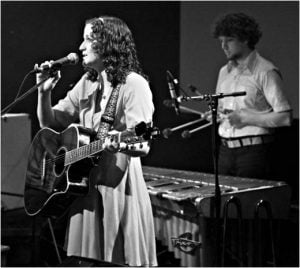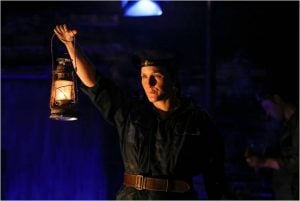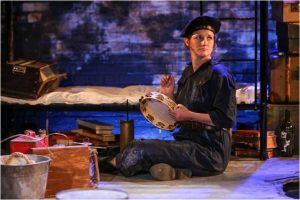
Photo credit: Jennifer Pelligrini
Prior to the upcoming tour of Narvik, Lizzie Nunnery’s new play with songs, I got a chance to grill the playwright about the journey so far and what excitement lies ahead. As an award-winning playwright and songwriter, Lizzie is a wordsmith, so I’ll let her words speak for themselves…
Tell me about the origin of the story… What first sparked your interest?
It started with stories told to me by my Grandfather Bill Mothershaw (we called him Grandy) who was in the Navy during WWII in Norway and in the Arctic. He died in Feb 2015 at 91 and in the last few years of his life talked a lot more about his war- good and bad memories. He was a teenager in WWII and it struck me that the last of the men who fought in that war are now disappearing. I got fascinated by the idea of this generation of boys who got on ships, sailed away and saw everything they thought they knew blown apart. Seeing my Grandy at the end of such a long life with so much still vivid in his mind I also got stuck on the theme of memory and how it can haunt, how it can disorder story and maybe even distort truth – so from the start it was clear the play wasn’t going to take a conventional linear structure.
I know you did a lot of research for the play. Where did this journey of discovery lead? How did it unfold?
Within the development and writing process, Director Hannah Tyrrell-Pinder visited museums, read loads of history books and real accounts, spent time mapping out journeys of particular ships in WWII and imagining various routes through the war and across the globe for the central character, Jim. I remember the Imperial War Museum in Salford having a particular impact—the architecture of it as much as the exhibitions. Every line and every space in there in some way articulates fragmentation, things shattered and scattered and transformed. That idea really stuck with us I think. We kept coming back to two ideas: how morally disorientating it was to live through war at sea, and how much pressure there was to be heroic when called upon- how crushing that pressure must have been. These fellas would sail around for months on end just waiting, waiting until they had to act in an instant, and when that instant came, what if they couldn’t? So I came up with the character Jim (played by Joe Shipman), a boy from Everton who falls in love with a Norwegian girl before the war, who experiences feeling like a hero at the battle of Narvik soon after, but then spends the rest of the war trying to get back to that point of love and clarity.
How much of the piece is based on true stories? (It must be difficult to assert where ‘truth’ ends and ‘story’ begins?!)
Truth and fiction are still quite separate in my mind. I wanted to find the most dramatic way to explore our themes, so truth was a place to jump off from, a point of inspiration I could return to, a source of detail and authenticity. Grandy grew up in Everton and at 18 joined the Navy, serving during WWII in the Arctic and the Atlantic, rising to the rank of Petty Officer. He wasn’t at the battle of Narvik but did sail to Narvik later in the war. He told me about the cold in the Arctic—how the deck would be frozen with vomit and you’d go slipping over it, how your p**s would freeze when you went to the loo outside. At times he’d talk passionately about his war years: ‘Great days… You really felt you were doing something’. His boat was part of the flotilla that took Norway’s Prince Olav back to Oslo after the war (Olav and his father Hakon were both exiled in London after the invasion of Norway early in the conflict) and Grandy was tremendously proud of that. He told that story often – how the starving people rowed in to the fjord in their little boats to meet the flotilla, how the sailors threw bread down to them and were welcomed as heroes.
Once he described the horrific way ‘quizlings’ were treated at that time—particularly women who had associated with Germans—their hair cut off and paraded through the streets. They’d be killed and their bodies put on show… Just once he told me that he and some fellow sailors had chased and cornered a group of SS in a building in Oslo. I asked if they shot them all and he said ‘Well we didn’t let them go’. He was never in Oslo before the war (like our character Jim) but he mentioned he had a girlfriend in the city in that brief period after the war. He lived on a street called Gables Gate and I think had good times there – his eyes lit up when he talked about Oslo: he could still see it. While Jim struggles with heroism and expectation, Grandy was in fact an extraordinarily brave man. He once told me he volunteered to clear dead bodies from the flooded deck of a ship, because he ‘knew he could do it’ when others couldn’t.

Photo credit: Decoy Media
How does Narvik fit in/ resonate with your previous works? Are you often drawn towards fictionalising history? Or is this something totally new for you?
I’ve written several history plays before for stage and radio. I’ve always loved history as a way of accessing truths about people, about behaviour. You can draw parallels, see patterns emerge. Theatre is a live medium and it has to be about now—that’s a basic requirement—but sometimes it feels like the clearest way to talk about now is to talk about then. My first play ‘Intemperance’ (Liverpool Everyman) was set in Liverpool in 1854 but I was of course trying to articulate something about Liverpool 2007 as we approached the capital of culture year and felt our identity as a city shifting around us. In some ways Narvik is a contemporary play because the action is all scattered memories of Jim as an old man – it’s all filtered through that modern perspective as he struggles to make sense of the past. I’ve got a new play on at the Everyman in May 2017 which is all set in present day and takes on contemporary politics, so it’s been interesting to move between the two scripts, between the longview of history and the close up calamity of present day.
How do you think the production has progressed from its first run in Liverpool to the current tour? How much should a keen audience member expect it to have changed or developed?
The production is still a work in progress. We go in to rehearsal in January and will be working with two new musicians (Maz O’Connor and Joe Hirons) in addition to the original actors and multi-instrumentalist Vidar Norheim. I’m really excited about what those new performers will bring. They’re both composers, songwriters and highly skilled musicians so alongside Vidar I’m certain they’ll push the live soundtrack in thrilling new directions, building on the work we did last time around.
We also have a new designer on board, Katie Scott, who has reimagined the set in response to lots of research into naval history and also in response to the variety of spaces the show will tour to. I can’t give too much away but the early models and drawings look amazing. It’s going to be a really intense and versatile space, with parts of the set doubling as percussive instruments! I’ve been working away on the script since the original ru n- not big changes but lots of little tweaks. It’s such a luxury to put a script in front of an audience for two weeks and read their responses over different nights. I was particularly keen to develop the character of Jim’s father more—give him a fuller journey—so it’s been fun getting to know him a bit better in the latest draft.
Why include music? What, for you, does that add to the storytelling capabilities?
From our earliest conversations about working together, Hannah and I wanted to make a show with music threaded through: a live soundtrack that could draw the audience in to the experience of the characters. I’ve been working as a singer and songwriter for longer than I’ve been writing plays and Hannah was keen to find a way of integrating those two strands. As soon as we hit upon the theme of memory it made perfect sense that music should weave through the piece. In Narvik we introduce songs in naturalistic contexts within scenes and then allow them to morph and fragment across the structure of the play, so a song which was first a reassuring lullaby can become a trigger for much stranger darker memories for Jim. I’m fascinated by the different ways that music can operate on stage: how it can illuminate and underline emotion, accelerate storytelling and act as short hand, how it can be an intimate conversation with the audience that the characters aren’t aware of. It’s an ongoing experiment and adventure.
And finally, the juicy one: Who’s your favourite character? Or what’s your favourite aspect of the play?
Else’s my favourite. I love her strength, passion, and practicality. And from a dramatic point of view I’m drawn to the complexity of her position. Jim learns painfully that she isn’t and can’t be the perfect woman he’s idolised. She feels true to me because she occupies an ambiguous moral space in the actions she takes. Like so many women in war she gets swept beneath the tide of conflict and forgotten. Narvik had to be Jim’s story, told from his perspective in order to make sense, but I have considered writing the Else play too… or at least a play that looks at the lesser known stories of women in war. Women have so often been written out of the story, blotted out of the picture.

Photo credit: Decoy Media
Narvik opens at HOME, Manchester on January 31st 2017 before commencing a nationwide tour which will end on March 25th. Click here for more information.
Filed under: Theatre & Dance
Tagged with: HOME, interview, leeds, Lizzie Nunnery, manchester, Narvik, Playwright, theatre


Comments